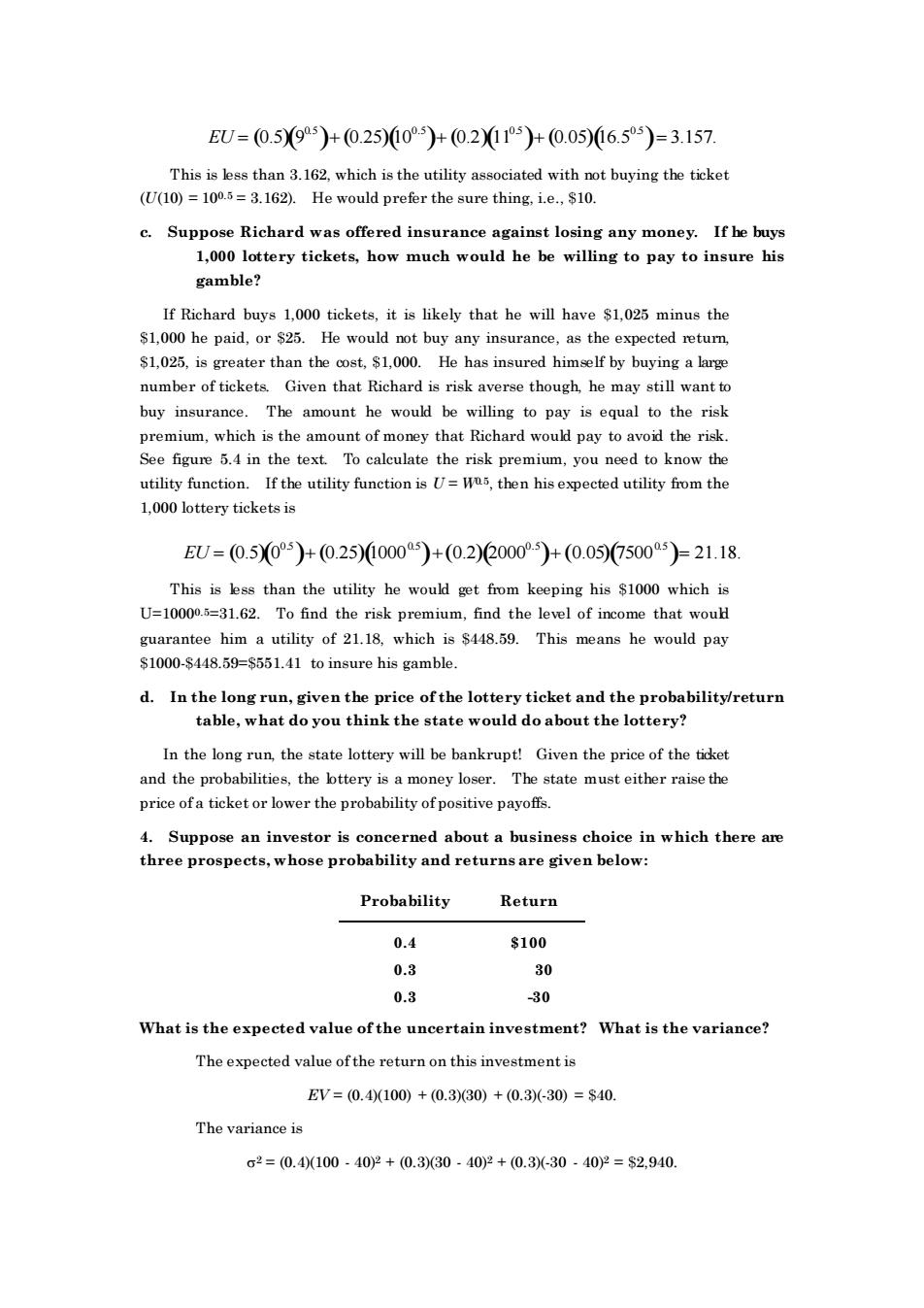正在加载图片...

EU=(0.59s)+0.25)00+(0.21105)+(0.05)06.5)=3.157. c.Suppose Richard was offered insurance against losing any money.If he buys 1,000 lottery tickets,how much would he be willing to pay to insure his gamble? If Richard buys 1000 tickets.it is likely that he will have $1025 minus the the exp $1,025.is greater than the cost,00. elf by buy ng a larg number of tickets.Given that Richard is risk averse though,he may still want t buy insurance.The amount he would be willing to pay is equal to the risk premium,which is the amount of money that Richard would pay to avoid the risk. See figure 5.4 in the text To calculate the risk pr emium.you need to know the utility function.If the utility function isU=,then his expected utility from the EU=(0.50°5)+(0.25)00005)+(0.2)000°)+(0.0575005)21.18. This is less than the utility he would get from keeping his $1000 which is U=100005=31.62.To find the risk premium,find the level of income that woul d.In the long run,given the price ofthe lottery ticket and the probability/return table,what do you think the state would do about the lottery? In the long run,the state lottery will be bankrupt!Given the price of the ticket and the probabilities.the lottery is a money loser.The state must either raise the price of a ticket or lower the probability of positive payoff e an investor is concerned about a business choice in which there are e prosp ects,whose probability and returns are given below Probability Return 0.4 $100 .3 30 0.3 30 What is the expected value of the uncertain investment?What is the variance? The expected value of the return on this investment is EV=(0.4(100)+(0.330)+(0.3(-30)=$40 The variance is 2=(0.4100.40P+(0.330.40+0.3-30.40P=2,940 EU = (0.5) 9 0.5 ( )+ (0.25) 100.5 ( )+ (0.2) 110.5 ( )+ (0.05) 16.5 0.5 ( )= 3.157. This is less than 3.162, which is the utility associated with not buying the ticket (U(10) = 100.5 = 3.162). He would prefer the sure thing, i.e., $10. c. Suppose Richard was offered insurance against losing any money. If he buys 1,000 lottery tickets, how much would he be willing to pay to insure his gamble? If Richard buys 1,000 tickets, it is likely that he will have $1,025 minus the $1,000 he paid, or $25. He would not buy any insurance, as the expected return, $1,025, is greater than the cost, $1,000. He has insured himself by buying a large number of tickets. Given that Richard is risk averse though, he may still want to buy insurance. The amount he would be willing to pay is equal to the risk premium, which is the amount of money that Richard would pay to avoid the risk. See figure 5.4 in the text. To calculate the risk premium, you need to know the utility function. If the utility function is U = W0.5, then his expected utility from the 1,000 lottery tickets is EU = (0.5) 0 0.5 ( )+ (0.25) 10000.5 ( )+(0.2) 20000.5 ( )+ (0.05) 75000.5 ( )= 21.18. This is less than the utility he would get from keeping his $1000 which is U=10000.5=31.62. To find the risk premium, find the level of income that would guarantee him a utility of 21.18, which is $448.59. This means he would pay $1000-$448.59=$551.41 to insure his gamble. d. In the long run, given the price of the lottery ticket and the probability/return table, what do you think the state would do about the lottery? In the long run, the state lottery will be bankrupt! Given the price of the ticket and the probabilities, the lottery is a money loser. The state must either raise the price of a ticket or lower the probability of positive payoffs. 4. Suppose an investor is concerned about a business choice in which there are three prospects, whose probability and returns are given below: Probability Return 0.4 $100 0.3 30 0.3 -30 What is the expected value of the uncertain investment? What is the variance? The expected value of the return on this investment is EV = (0.4)(100) + (0.3)(30) + (0.3)(-30) = $40. The variance is 2 = (0.4)(100 - 40)2 + (0.3)(30 - 40)2 + (0.3)(-30 - 40)2 = $2,940